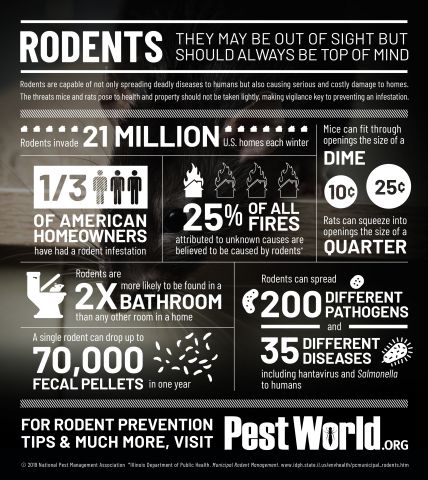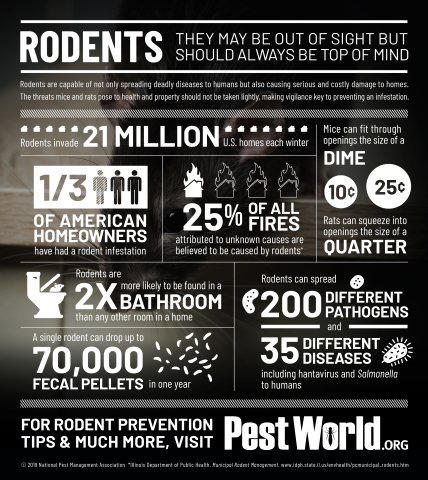FAIRFAX, Va.--(BUSINESS WIRE)--Rodents invade 21 million homes each winter and are found twice as often in the bathroom than any other room in the home. Revealed to be America’s biggest pest concern related to home and health issues through a recent online research study conducted between January 2018 and September 2019 by Advanced Symbolics Inc. using a representative sample of 274,500 Americans, the National Pest Management Association (NPMA) is sharing everything homeowners need to know about these invaders during Rodent Awareness Week this October 20-26, 2019, including the dangers they pose and how to prevent them.
“It’s a common misconception that pest pressure is lower during the cooler months, but rodents are adept survivors and instead move indoors in record numbers in search of food and warmth as temperatures drop,” said Cindy Mannes, vice president of public affairs for NPMA. “This is a huge concern for homeowners nationwide as mice and rats are vectors of many dangerous diseases and can also cause significant property damage as well. By being able to identify the rodent species entering the home, homeowners will be better equipped to prevent them.”
House Mouse
House mice are typically dusty gray with cream-colored bellies and can be found throughout the U.S. nesting in dark, secluded areas within structures. They are excellent climbers and can jump up to a foot high. House mice can cause serious property damage by chewing through materials and have been known to spark electrical fires by gnawing on wires inside homes. These rodents are also a health threat, as they can contaminate stored food and spread diseases like Salmonella, tapeworm and the plague.
Deer Mouse
Deer mice are brown with white underbellies and are found throughout the U.S. They prefer to nest in rural areas, specifically in fence posts, tree hollows and log piles. Deer mice pose a significant health threat because they can carry blacklegged ticks into the home and are the most common carrier of hantavirus. Hantavirus is transmitted primarily by the inhalation of dust particles contaminated with the urine, feces or saliva of infected deer mice.
Roof Rat
Originating from South East Asia, roof rats are now found in the coastal states and southern third of the U.S. They have soft and smooth fur that is typically brown with intermixed spots of black and their undersides are often white, gray or black. They live in colonies and prefer to nest in upper parts of structures or in trees, and can spread numerous diseases such as typhus, jaundice, rat-bite fever, trichinosis and Salmonella.
Norway Rat
Like house and deer mice, Norway rats are found throughout the U.S. They are primarily nocturnal and often burrow in piles of garbage or under concrete slabs. They tend to enter homes in the fall and will nest in basements, attics and other undisturbed dwellings. Norway rats can cause significant damage to property by gnawing through a variety of materials, including plastic and lead pipes. They can also transmit diseases such as plague, jaundice, rat-bite fever, cowpox virus, trichinosis and Salmonella. In addition, these rats can also introduce fleas and mites into a home.
To help prevent rodents from entering your home this winter, NPMA is sharing the following 10 tips:
- Insert door sweeps on exterior doors and repair damaged screens.
- Screen vents and openings to chimneys.
- Seal cracks and holes on the outside of the home, including areas where utilities enter.
- Store food in airtight containers and dispose of garbage regularly.
- Keep attics, basements and crawl spaces well ventilated and dry.
- Replace loose mortar and weather stripping around the basement foundation and windows.
- Eliminate all moisture sites, including leaking pipes and clogged drains that provide the perfect breeding site for pests.
- Inspect items such as boxes, grocery bags and other packages before bringing them into the home.
- Store firewood at least 20 feet away from the house and keep shrubbery well-trimmed.
- If you suspect a pest infestation in your home, contact a licensed pest control professional to inspect and treat the problem.
For more information on rodents and how to prevent them, visit PestWorld.org
About the National Pest Management Association
The NPMA, a non-profit organization with more than 5,500 members, was established in 1933 to support the pest management industry's commitment to the protection of public health, food and property from the diseases and dangers of pests. For more information, visit PestWorld.org or follow @PestWorld on Facebook, Twitter, Pinterest and YouTube.




